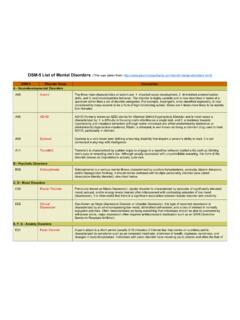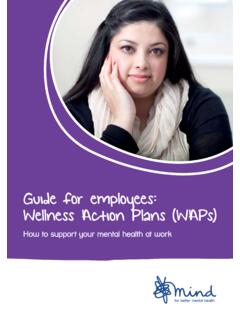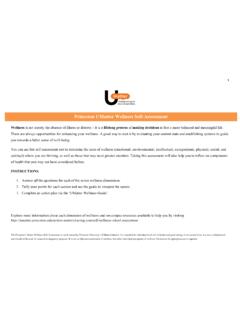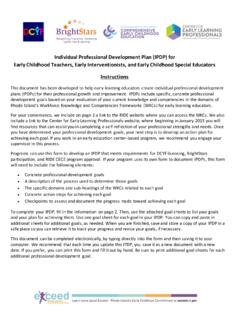Transcription of Action Planning for Prevention and Recovery
1 SMA-3720 Page 1 Action Planning for Prevention and RecoveryAction Planning for Prevention and RecoveryAcknowledgementsThis publication was funded by the Department of Health and Human Services (DHHS), Substance Abuse and Mental Health Services Administration (SAMHSA), Center for Mental Health Services (CMHS), and prepared by Mary Ellen Copeland, , , under contract number 99M005957. Acknowledgment is given to the many mental health consumers who worked on this project offering advice and The opinions expressed in this document reflect the personal opinions of the author and are not intended to represent the views, positions, or policies of CMHS, SAMHSA, DHHS, or other agencies or offices of the Fed-eral Domain Notice All material appearing in this report is in the public domain and may be reproduced or copied without permis-sion from SAMHSA.
2 Citation of the source is appreciated. However, this publication may not be reproduced or distributed for a fee without the specific, written authorization of the Office of Communications, SAMHSA, additional copies of this document, please call SAMHSA s National Mental Health Information Center at Office Center for Mental Health Services Substance Abuse and Mental Health Services Administration 5600 Fishers Lane, Room 15-99 Rockville, MD 20857 SMA-3720 07/2003 Table of ContentsForeword.. 2 Introduction.. 2 Developing a wellness Toolbox .. 3 Daily Maintenance plan .. 3 Triggers.. 5 Early Warning Signs.
3 6 When Things Are Breaking Down or Getting Worse.. 7 Crisis Planning .. 8 Using Your Action Plans ..11 Further Resources ..12 SMA-3720 Page 2 Action Planning for Prevention and RecoveryForewordThis booklet contains information, ideas, and strategies that people from all over the country have found to be helpful in relieving and preventing troubling feelings and symptoms. The information in this booklet can be used safely along with your other health care may want to read through this booklet at least once before you begin working on developing your own ac-tion plans for Prevention and Recovery . This can help enhance your understanding of the entire process.
4 Then you can go back to work on each section. You may want to do this slowly, working on a portion of it and then putting it aside and revise it on a regular basis as you learn new things about yourself and ways you can help yourself to feel G. Curie, , Administrator Substance Abuse and Mental Health Services AdministrationBernard S. Arons, Director Center for Mental Health ServicesIntroductionDo you experience feelings and symptoms that are upsetting, that keep you from being the way you want to be and doing the things you want to do? Many people who have troubling emotional, psychiatric, or physical symptoms have made great advances in learning how to do things to help themselves get well and stay well.
5 One of the most frustrating stages of recovering your health is when you realize that you can do many things to help yourself stay well but you can t figure out a way to do them regularly. It is easy to forget simple things that you know, especially when you are under stress or when your symptoms are beginning to flare up. The Action plans for Prevention and Recovery described in this booklet were devised by people who experience emotional or psychiatric symptoms. They developed ways to deal with their need for structure in their lives that actively support their health. The plans are simple, low-cost, and can be changed and added to over time as you learn more and more.
6 Anyone can develop and use these plans for any kind of health concern. People using this system report that by being prepared and taking Action as necessary, they feel better more often and have improved the overall quality of their lives dramatically. One person said, Finally, there s some-thing I can do to help myself. Action plans for Prevention and Recovery work because they are easy to develop and easy to use are individualized. You develop your plan for yourself. No one else can do it for you; however, you can reach out to others for assistance and support improve your ability to communicate effectively with your family members and health care pro-viders directly address the feelings, symptoms, circumstances, and events that are most troubling to you with plans to respond to them renew your sense of hope that things can and will get better, and that you have control over your life and the way you feel SMA-3720 Page 3 Action Planning for Prevention and RecoveryDeveloping a wellness ToolboxTo develop this plan , the only materials you need are a three-ring binder.
7 A set of five tabs or dividers, and lined three-hole paper. Before you begin working with the tabbed sections, you will create a resource list to keep in the beginning of your binder. This section is called the wellness Toolbox. In it you identify and list the things you use to help yourself feel better when you are having a hard time. Some of them are things you know you must do, like eating healthy meals and drinking plenty of water; others are things you could choose to do to help yourself feel better. You can also list things you would like to try using to keep yourself well or to help yourself feel better.
8 You will refer to this list for ideas when you are developing the tabbed sections of your plan . Some ideas for your wellness Toolbox might be eating three healthy meals a day drinking plenty of water getting to bed by 10:00 (or at a good regular time for you) doing something you enjoy like playing a musical instrument, watching a favorite TV show, knit-ting, or reading a good book exercising doing a relaxation exercise writing in your journal talking to a friend on the telephone taking medications taking vitamins and other food supplementsYou can get more ideas for your wellness Toolbox by noticing the good things you do as you go through your day, by asking your friends and family members for suggestions, and by looking into self-help resource books.
9 Write down everything, from really easily accessible things, like taking deep breaths, to things you only do once in a while, like getting a massage. This is a resource list for you to refer back to when you are developing your plans. Your wellness Toolbox works best for you if you have enough entries so you feel you have an abun-dance of choices. Just how many entries you have is up to you. If you feel positive and hopeful when you look at the list, then you have enough. You can continue to refine your wellness Toolbox over time, adding to your list whenever you get an idea of something you d like to try, and crossing things off your list if you find they no longer work for you ve gotten your wellness Toolbox underway, insert it into your notebook.
10 Then, insert your five tabbed dividers, with several sheets of paper after each tab and a supply of paper at the end of the Maintenance PlanOn the first tab write Daily Maintenance plan . If you haven t already done so, insert it in the binder along with several sheets of Well On the first page, describe yourself when you are feeling all right. If you can t remember, or don t know how you feel when you are well, describe how you would like to feel. Make it easy. Make a list. Some descriptive words that others have used include: bright, talkative, outgoing, energetic, humorous, reasonable, argumentative.






